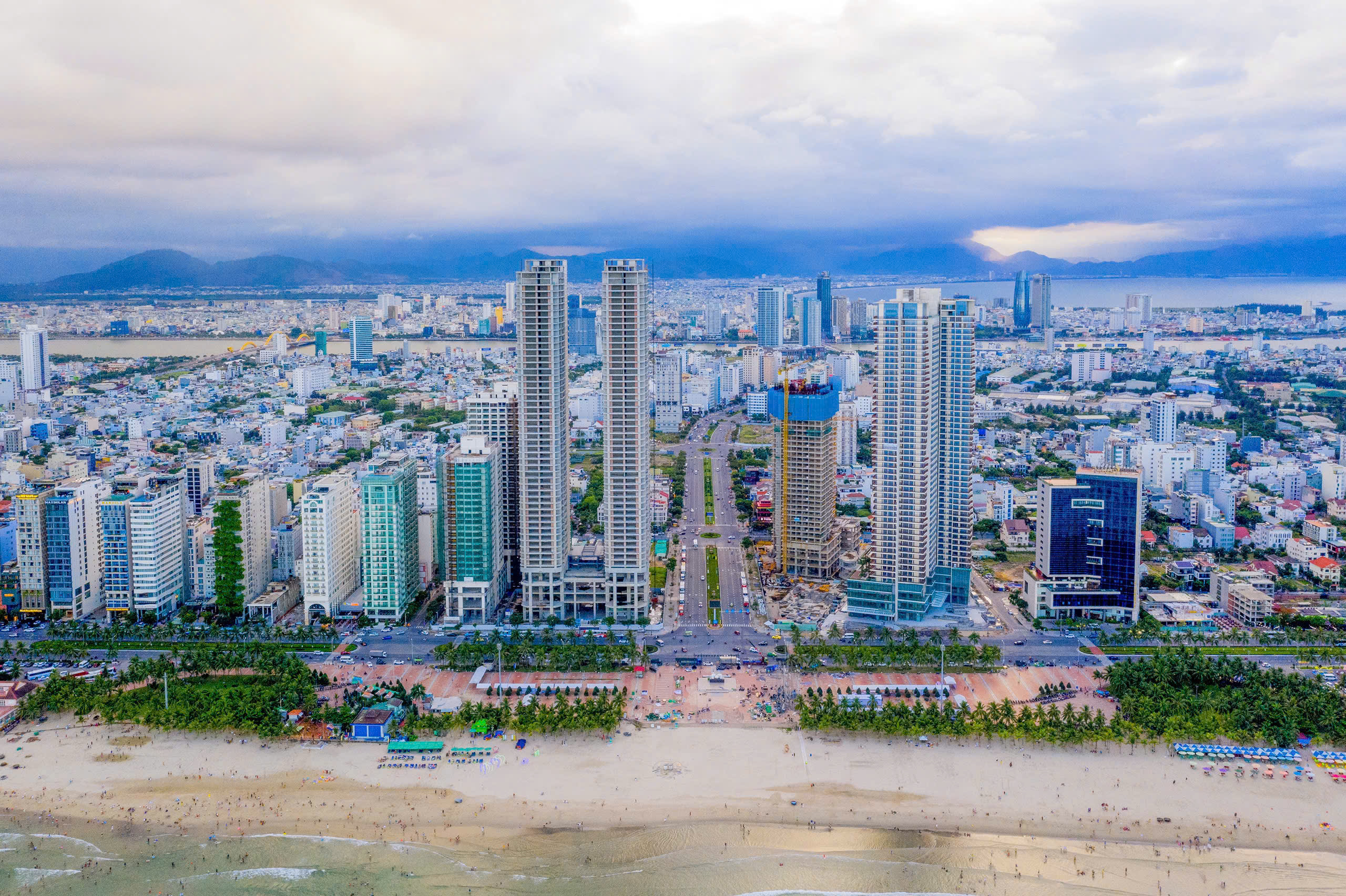Integrated planning for sustainable tourism development
Planning and developing coastal urban areas are not a new issue, but this remains highly relevant, especially for a city like Da Nang with a coastline of around 74km. Mr Phung Phu Phong, Director of the Da Nang Department of Construction, affirmed that in recent times, the planning and development of coastal hotel infrastructure and services have been vigorously implemented, aimed at promoting tourism and local economic growth.
 |
| The planning of coastal infrastructure and services has essentially taken shape, giving Da Nang a modern appearance. Photo: TUAN LE |
How has integrated planning tied to sustainable tourism development, specifically the planning and development of coastal hotel infrastructure and services in Da Nang, been implemented, Mr Phong?
Da Nang has a coastline of about 74km with many beaches and landscapes suitable for tourism and resort services. Moreover, with its steep terrain towards the west, urban infrastructure has long been concentrated along the coast. The formation and development of Da Nang's urban areas depend heavily on the sea, so this factor is always carefully considered in urban planning and management. Recently, the planning and development of coastal hotel infrastructure and services have been vigorously and systematically implemented, with the goal of boosting tourism and local economic growth. Alongside this, land use planning and the conversion of residential land in existing urban areas, especially on the eastern shore, into commercial, service, and mixed-use land, have been promoted. This allows Da Nang to form a vibrant coastal area where people can work, live, and enjoy leisure activities.
So far, the city has shaped its development direction by enhancing existing characteristics and emphasising water features (rivers and seas) through connected public spaces. Several prominent coastal areas have been vigorously planned and developed, focusing on hotel and service infrastructure, luxury resorts of international standards, such as My Khe Beach, Marble Mountains, and Son Tra area. Coastal services and entertainment activities like spas, water sports, and outdoor activities have expanded, offering tourists a variety of options. Additionally, the transport system connecting coastal tourist areas to other parts of the city has been upgraded and expanded. Recently, the city launched the construction of the Lien Chieu seaport, focusing on the development of Lien Chieu port, a logistics complex, and a seaport urban area, aimed at enhancing Da Nang's position as an international logistics hub.
In this context, how is the balance between economic development, ensuring the public’s needs, and preserving coastal landscapes and nature being addressed?
Balancing economic development, meeting public needs, and preserving coastal landscapes and nature is a significant challenge. In fact, over the years, coastal tourism and services have greatly contributed to local economic growth, created numerous jobs, and spurred the development of supporting industries and services.
Da Nang has been developing urban infrastructure and public services, making it more convenient for both residents and tourists. Generally, the city has been quite successful in planning and developing coastal hotel infrastructure and services through sustainable and integrated approaches. Coastal area planning has been carried out harmoniously, considering sustainable development factors, including conservation areas, parks, and green spaces to maintain the natural landscape.
Tourism and infrastructure development not only focus on economic benefits but also pay attention to the needs and benefits of the local community, while protecting the environment and ecosystems. For example, coastal hotels and resorts are designed according to plans with architecture that reflects local cultural traditions, ensuring that the existing landscape is not overly altered, based on preserving cultural heritage and historical relics and promoting indigenous culture.
What is the most crucial solution to balance the interests of residents and the need for coastal urban development in Da Nang?
Ensuring the participation of the local community in planning and development decisions is vital. Through dialogue and cooperation among stakeholders, including the government, businesses, environmental organisations, and the local community, sustainable and reasonable development solutions can be found. These factors ensure that coastal hotel infrastructure and services development in Da Nang does not solely focus on economic benefits but also takes into account the protection and maintenance of the natural landscape, creating a sustainable and attractive environment for both tourists and local residents.
In recent times, the city has focused on creating public spaces by integrating parks, beaches, and entertainment areas, providing green spaces for residents and visitors to relax and enjoy the coastal atmosphere. Walkways to the beach and paths made of eco-friendly materials like wood or natural stone have been designed with gentle slopes to avoid obstructing movement and to preserve the natural landscape. Moreover, local authorities are actively opening natural pathways to the sea and creating resting stops such as information kiosks, snack bars, and public toilets to meet visitors' needs.
Additionally, Da Nang has been promoting education and raising community awareness about the importance of environmental protection and sustainable development practices. Citizens and tourists are encouraged to participate in environmental protection activities, beach clean-ups, and reducing plastic waste, as well as complying with regulations on protecting marine flora and fauna. Ecotourism and sustainable tourism are promoted, where tourists can enjoy the landscape and nature without causing harm to the environment. At the same time, the city's tourism sector manages the number of tourists, ensuring that tourism and services do not exceed the local ecosystem's carrying capacity.
Reporting by KHANH HOA - Translating by TRUC VY